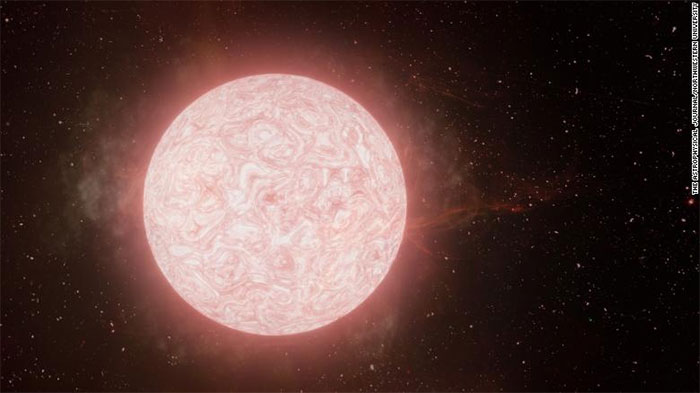Astronomers have observed the “death throes” of a giant star as it explodes, marking the end of its existence.
According to CNN, ground-based telescopes have enabled scientists to witness this event in real-time for the first time. The event involves a “supergiant” red star. Although these stars are not the brightest or largest, they are the most massive stars known.

Illustration of a red supergiant star ejecting gas in its final year of existence. (Photo: CNN)
The star in question is located in the NGC 5731 galaxy, approximately 120 million light-years from Earth, with a mass about ten times that of the Sun before it exploded.
Before fading away, some stars undergo violent eruptions or release bright, hot gas layers. Previously, when astronomers had not observed this event, they believed that red supergiants remained relatively quiet before exploding into supernovae or collapsing into dense neutron stars.
However, upon observation, scientists found that the star self-destructed violently, transforming into a supernova. The star’s death involves a rapid disintegration and explosive end after it burns brightly using hydrogen, helium, and other elements in its core.
All that remains is the iron of the star, but iron does not easily melt, leading the star to exhaust its energy. When that happens, the iron will explode, resulting in a supernova.
A detailed study of these findings was published on January 6 in the Astrophysical Journal.
Wynn Jacobson-Galán, a research fellow at the National Science Foundation at the University of California, Berkeley, stated: “This is a breakthrough in our understanding of the behavior of giant stars just before they die. This is the first time we have directly observed pre-supernova activity in a red supergiant, which has never been seen in a typical Type II supernova before. For the first time, we witnessed a red supergiant star explode.”
Astronomers were first alerted to the unusual activity of this star 130 days before it became a supernova. The bright radiation was detected in the summer of 2020 using the Pan-STARRS telescope at the University of Hawaii.
Then, in the fall of that year, researchers observed a supernova at the same location.
They monitored it using the Low-Resolution Imaging Spectrograph at the W.M. Keck Observatory in Maunakea, Hawaii. They named it supernova 2020tlf. Their observations indicated that there was material surrounding the star as it exploded. This was bright gas that had been vigorously erupting from the star throughout the summer.
Senior study author Raffaella Margutti, an associate professor of astronomy and astrophysics at UC Berkeley, said in a statement: “It’s like watching a ticking time bomb. It’s only now that we can confirm such intense activity in a dying red supergiant star.”
Some of these massive stars may undergo internal changes, causing a chaotic gas release before they die.


















































